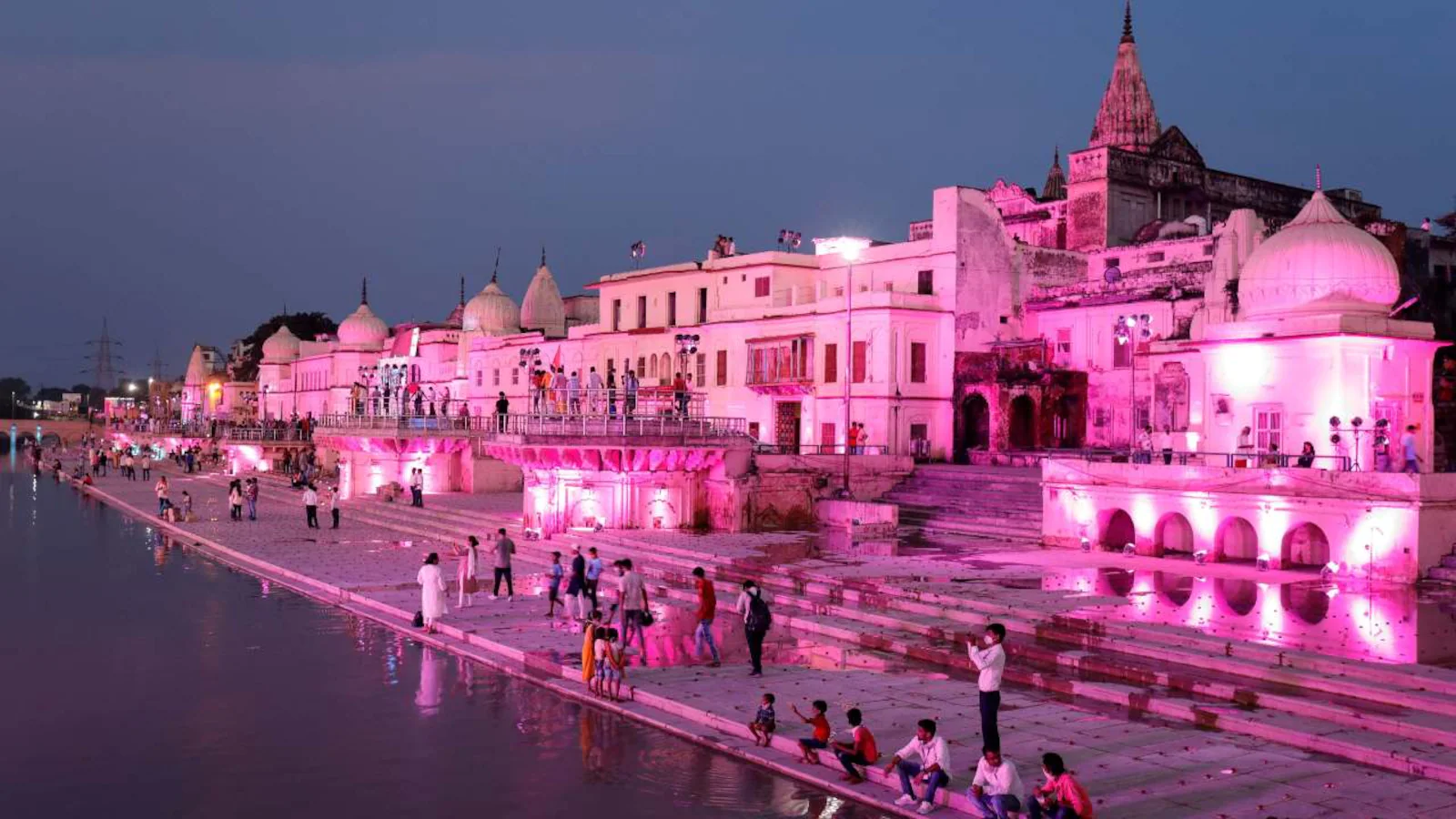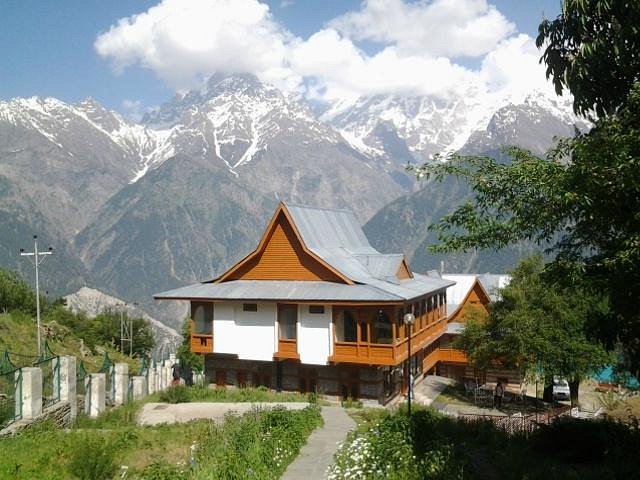
Ayodhya is a city located in the Indian state of Uttar Pradesh. It is renowned as the birthplace of Lord Rama and a major pilgrimage destination.
Positioned on the banks of the Sarayu River, It holds a sacred spot in Indian mythology and history. This ancient city is a crucial part of India’s cultural and religious landscape, attracting millions of devotees every year. The historical and mythological significance of It’s stems from its depiction as the setting of the Hindu epic, the Ramayana.
Here, visitors can explore a myriad of temples, with the prominent Ram Janmabhoomi temple being a significant attraction since it marks the believed birthplace of Lord Rama. Ayodhya’s religious heritage spans centuries and embodies the spiritual heart of Hinduism. It has recently garnered global attention due to archaeological findings and the protracted legal disputes surrounding the Ram Temple. The city’s rich tapestry of culture, tradition, and devotion makes it a key destination for tourists seeking to experience the essence of Indian spirituality.
History Of Ayodhya
The city of Ayodhya, nestled on the banks of the sacred Sarayu River, boasts an intricate tapestry of history intertwined with myth and spirituality. It commands reverence as a cradle of ancient civilizations and echoes with tales of divine incarnations, making it a vital piece of India’s cultural heritage.
Early Settlements
The origins of this city is as old as the concept of cities themselves. Archaeological finds suggest thriving societies dating back thousands of years. Excavations reveal remnants of pottery, tools, and structures that speak to sophisticated urban planning and cultural development.
- Ancient texts pinpoint it’s as a significant city in the Vedic Period.
- Sophisticated artifacts suggest trade and cultural exchanges with other regions.
- The city’s layout indicates knowledge of urban design principles early on.
Legendary Aspects
The city transcends mere history to encompass the realm of legend. It is revered as the birthplace of Lord Rama, an avatar of the Hindu god Vishnu. This aspect has influenced the city’s identity profoundly.
The epic Ramayana narrates Rama’s life and kingship in this city, etching the city into the hearts of believers. Temples and ghats here bear witness to the deep-seated spiritual significance of Ayodhya in Hindu folklore.
- Ramayana’s influence perpetuates through annual festivals and rituals.
- It’s spiritual legacy draws thousands of pilgrims yearly.
- Temples and historical sites create a mosaic of the city’s divine heritage.
Religious Significance
The religious importance of Ayodhya is vast and ancient. This city, drenched in devotion, stands at the spiritual core for multiple faiths. It’s a confluence of history, myth, and worship that has attracted pilgrims over millennia. Here’s a glimpse into how Ayodhya resonates with diverse beliefs.
Hinduism
This city is a sanctified citadel in the realm of Hinduism. Known as the birthplace of Lord Rama, an incarnation of Vishnu, the city holds immense spiritual significance. Devotees gather from far and wide to soak in its divine aura, particularly at the site of the Ram Janmabhoomi temple. Festivals like Diwali, which celebrates Rama’s return to the city, are radiant with millions of lights and unbounded faith.
- Ram Janmabhoomi: The most revered site in this city.
- Diwali celebrations: Marking Lord Rama’s return.
Buddhism
Buddhism’s tapestry also weaves through the city. It’s believed that Lord Buddha visited and taught here, adding layers to the town’s sacred narrative. The Ananda Kuti and Brahma Kuti are sites where Buddha is said to have stayed, making these significant spots for followers. Important Buddhist scriptures also mention the city, spotlighting its historical spiritual stature.
- Ananda Kuti and Brahma Kuti: Stay of Buddha.
- Scriptural mentions: Testaments in Buddhist texts.
Jainism
In Jainism, Ayodhya gains prominence as the birthplace of two Tirthankaras, Adinath (Rishabhanatha) and Anantnath. As such, it’s a key pilgrimage destination for Jains. The city hosts temples and monuments linked to Jain history, symbolizing the deep-seated reverence within the Jain community. The confluence of Jain philosophy and Ayodhya’s ambiance is powerful and palpable.
| Tirthankaras from Ayodhya | Significance |
|---|---|
| Adinath (Rishabhanatha) | First Tirthankara, revered birthplace. |
| Anantnath | A cherished figure in Jain lore. |
Ayodhya Dispute
The Ayodhya Dispute grips a historical city in northern India. This dispute blends faith, history, and law. It involves a site revered by Hindus and Muslims. Generations have discussed, debated, and fought over this land.
Babri Masjid Demolition
On December 6, 1992, a significant event shook India. A large crowd demolished the Babri Masjid. They claimed an ancient temple existed there. This mosque stood since the 16th century. It was built by Mir Baqi, on orders from Mughal emperor Babur.
The demolition led to widespread riots across India. Many people lost their lives. The incident set off a chain of events, changing India’s political landscape forever.
Court Verdicts
- 2003 Archaeological Survey: Evidence suggested a structure beneath the mosque.
- 2010 High Court Ruling: The land split between Hindus and Muslims.
- 2019 Supreme Court Verdict: The entire disputed land given to Hindu groups. Muslims were allotted separate land to build a mosque.
The court’s decision aimed to resolve a century-old conflict. The judgement was historic. It was based on evidence, legal principles, and a desire for harmony.
Archaeological Findings
The past of Ayodhya is rich, with layers of history buried beneath its surface. Archaeological findings in Ayodhya offer a glimpse into ancient civilizations and their way of life. Digging through time, archaeologists have unearthed a number of artifacts that tell stories about the people who once walked these lands.
Excavations
Extensive excavations have taken place in Ayodhya over the years. These digs aim to uncover the factual layers of history that the city stands upon. Due to Ayodhya’s significance in religious texts, excavations are delicate and deeply scrutinized, balancing historical context with respect for cultural beliefs.
- First phase of excavations by B.B. Lal (1975-1980)
- Follow-up excavations by the Archaeological Survey of India (ASI) in 2003
Discoveries
Ayodhya’s excavations have revealed fascinating finds that tell the tale of its ancient grandeur. Among these, the following discoveries stand out:
| Item | Description | Period |
|---|---|---|
| Structures | Remnants of religious structures | 11th-12th Century CE |
| Pottery | Variety of pots and dishes | Various eras |
| Pillars | Carved pillars, possibly part of a temple | Early medieval period |
| Inscriptions | Inscribed with ancient scripts | 5th-6th Century CE |
Every artifact brings Ayodhya’s vibrant past into the present, eliciting awe and reverence for the civilizations that called this city home.
Cultural Heritage
The heart of India’s cultural richness pulses strongly in the ancient city of Ayodhya. Steeped in history and mythology, its cultural heritage paints a vibrant tableau of spiritual traditions. From timeless festivals to the distinct art and architecture, Ayodhya’s cultural landscape is a spellbinding journey through India’s storied past.
Festivals
Ayodhya’s calendar is adorned with vibrant festivals. Each celebration brings its own blend of joy and devotion. The most illustrious of these is Diwali, heralding the return of Lord Ram to Ayodhya. The city lights up with millions of lamps, casting a celestial glow over the Ghats of Sarayu River. Ram Navami, the birth celebration of Lord Ram, sees throngs of devotees partaking in spirited processions and melodic bhajans.
- Ram Navami: Birth celebration of Lord Ram marked by processions.
- Diwali: City comes alive with lights to honor Lord Ram’s return.
- Makar Sankranti: Kite flying day symbolizing new beginnings.
Art And Architecture
The architectural splendor of Ayodhya narrates tales of an era bygone. The temples of Ayodhya showcase a blend of various architectural styles. Magnificent carvings and intricate designs symbolize the expertise of ancient craftsmen. The Ram Janmabhoomi temple, under construction, promises to be a nexus of cultural and spiritual grandeur that will draw the eyes of the world.
| Temple | Architectural Style | Highlights |
|---|---|---|
| Hanuman Garhi | Nagara | Sprawling campus with a 76-step stairway |
| Kanak Bhavan | Indo-Saracenic | Exquisite structure revered as Sita’s palace |
| Mani Parbat | Ancient Mound | Sacred hillock offering panoramic city views |
Modern Ayodhya
Ayodhya, a city steeped in antiquity, now surges forward into contemporary times. This sacred city, known mostly for its rich history and religious significance, is ray-shaping its image. A blend of cultural heritage and modern advancement brightens its horizon.
Economic Development
Recent years have seen Ayodhya’s economy flourish. Focused efforts by the government have brought about fresh opportunities. Industries are growing, and employment rates are on the rise. It’s a city with a robust economic future.
- Boost in local businesses, thanks to increased tourism.
- Government-supported infrastructure projects invite more investments.
- Emerging educational centers foster a skilled workforce.
Tourism
As a magnet for visitors, Ayodhya’s tourism scene is shining. The town’s religious sites continue to attract pilgrims worldwide. The local government is paving the way for a world-class visitor experience. Improved facilities and exciting cultural fests add to this charm.
| Attraction | Visitors per Year |
|---|---|
| Temples and Ritual Sites | Millions |
| Cultural Festivals | Lakhs |
New attractions and accommodations are emerging. They make stays more pleasant and culturally rich. Ayodhya is set to become a model of modern spirituality combined with growth and prosperity.
Social And Political Implications
The city of Ayodhya holds deep social and political significance. Its historical and religious relevance shapes the regional dynamics in distinctive ways. Understanding these complexities requires an insight into the relationships between communities and the role of governmental efforts.
Community Relations
Ayodhya’s social fabric is interwoven with various cultures and beliefs. The interplay among different communities in Ayodhya has always been pivotal. Following are critical facets of the current community relations:
- Interfaith dialogues and initiatives are a cornerstone in maintaining harmony.
- Local festivals often become a symbol of unity, transcending religious divides.
- Community-driven projects focus on common ground to foster mutual respect.
Government Initiatives
The government plays a crucial role in nurturing the city’s diverse nature while also addressing its pressing challenges. Recent policies and plans aim to strengthen socio-political ties. Here’s an outline of the significant measures:
- Rehabilitation projects for the improvement of infrastructure and living conditions.
- Investments in cultural heritage to promote tourism and drive economic growth.
- Programs to encourage dialogue and partnership between different societal segments.
Future Prospects
Ayodhya’s horizon gleams with promise as the city prepares for a transformative journey. The birthplace of Lord Rama, steeped in history and spiritual significance, now sets the stage for a future where harmony and progress coalesce.
Reconciliation Efforts
The heart of Ayodhya’s renaissance lies in mending historical rifts. Citizens and leaders unite in fostering a spirit of reconciliation. The city’s fabric is rewoven with threads of understanding and respect. Communal bonds strengthen as Ayodhya becomes a beacon of unity and peace.
Development Plans
Ambitious blueprints chart Ayodhya’s path to modernity. The city will see state-of-the-art infrastructure, enhancing connectivity and services. Planned are lush parks, world-class amenities, and a skyline punctuated with development marking Ayodhya’s comeback on the world stage.
- Better roads for smooth travel
- Eco-friendly public transport
- Advanced healthcare facilities
- Digital hubs for businesses
- Upgraded educational institutions
| Project | Benefit | Completion |
|---|---|---|
| Ayodhya Airport | Global connectivity | 2025 |
| Green Spaces | Healthier environment | Ongoing |
| Solar Power Plant | Clean energy | 2024 |
Frequently Asked Questions For Ayodhya
Why Is Ayodhya Famous?
Ayodhya is renowned as the birthplace of Lord Rama and as the setting of the Hindu epic, the Ramayana. It’s a key pilgrimage destination for Hindus worldwide.
Why Was Ayodhya Destroyed?
Ayodhya has faced destruction multiple times throughout history, often due to invasions and subsequent battles, including those led by the Mughal emperor Babur in the 16th century.
Is Ayodhya Really Birthplace Of Rama?
Ayodhya is widely considered the birthplace of Rama according to Hindu tradition. Evidence is largely based on religious texts rather than concrete archaeological proof.
Why Was Ayodhya Abandoned?
Ayodhya was abandoned due to several factors, including invasions, natural disasters, and historical neglect, leading to the decline of its significance and habitation over time.
Conclusion
Ayodhya’s tapestry of cultural heritage and enduring spirituality offers a unique journey for every traveler. This ancient city, rich in myth and tradition, stands as a testament to India’s diverse historical legacy. As you depart from its sacred ghats and temples, the stories of Ayodhya will echo, inviting reflection and promising a lasting impression on the soul.





